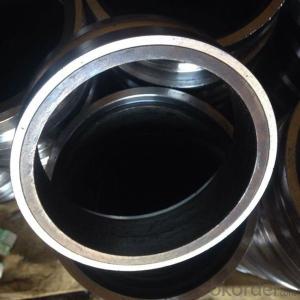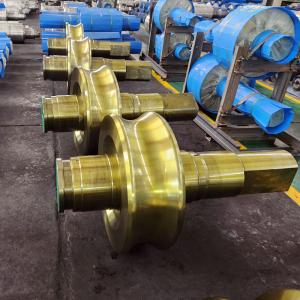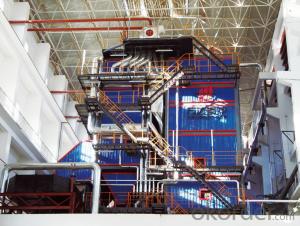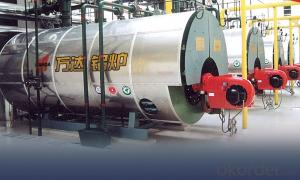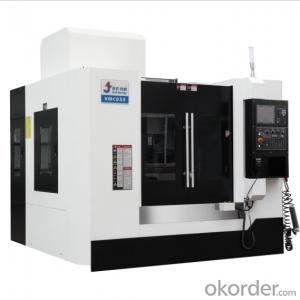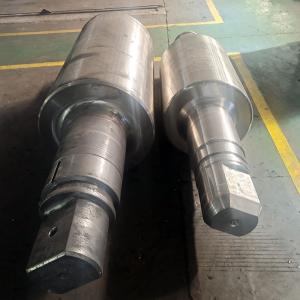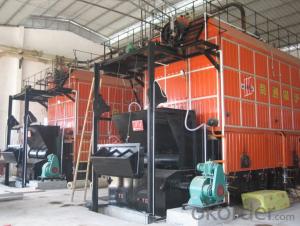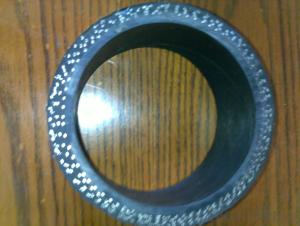Concrete Pumps Spare Parts Welding Flange Double Layer DN125MM X 35MM
- Loading Port:
- Tianjin
- Payment Terms:
- TT OR LC
- Min Order Qty:
- 100 pc
- Supply Capability:
- 100000 pc/month
OKorder Service Pledge
OKorder Financial Service
You Might Also Like
Product Description:
The Concrete Pumps Spare Parts Welding Flange Double Layer DN125MM X 35MM normally made by special MN13-4 insert, to make sure the quanlity of elbows according to customer’s requests we usually keep the content of MN strictly over 15%, it will have a longer life as well, package will be in plywood box or cartons and put into container.
Scope of Application of the Goods
The Concrete Pumps Spare Parts Welding Flange Double Layer DN125MM X 35MM is a concrete pumps parts for combined use with other concrete parts in for concrete pumps and truck pumps. It can be widely used in the construction of various types of concrete structures like industrial and civil buildings, bridges, roads, and other types of infrastructure.
This seals can only be used in Schwing type concrete pumps and truck pumps as well, but not in any other operations.
Product Advantages:
OKorder's Concrete Pumps Spare Parts Welding Flange Double Layer DN125MM X 35MM Channels are durable, strong, and safety.
Main Product Features:
· Premium quality
· Prompt delivery & seaworthy packing (5-10 days)
Reliable performance
Easy to weld
High safety.
· Professional Service
· Competitive pricing
Measuring of wall thickness from the outside
Low purchase cost
Specifications:
DN:125MM
Width:35MM
Material: ST52,MN
FAQ:
Q1: How long about delivery time Concrete Pumps Spare Parts Welding Flange Double Layer DN125MM X 35MM ?
A1: Normally we keep the raw materials for old customers and sometime we also keep stock products to make sure delivery time in any emergency cases.
Q2: How do we guarantee the quality of our Concrete Pumps Spare Parts Welding Flange Double Layer DN125MM X 35MM?
A2: We have established an advanced quality management system which conducts strict quality tests at every step, from raw materials to the final product. At the same time, we provide extensive follow-up service assurances as required.
Q3: How soon can we receive the product after purchase?
A3: Within three days of placing an order, we will book the vessel for goods. The specific shipping date is dependent upon international and government factors, but is typically 7 to 30 workdays.
Q4: If we can produce some goods according to customers request?
A4: Yes, we can produce Welding Flange Double Layer DN125MM X 35MM according to the difference country situations to make it suitable to the market and customers. We have very professional technical team to make the design for porduction of seals.
Q5: How to make a quick resolution for after service?
A5: OKorder and our manufacture both have overseas branches all-around of world.


- Q:How do I properly adjust and control flow rates in concrete pump spare parts?
- To properly adjust and control flow rates in concrete pump spare parts, there are a few key steps to follow: 1. Understand the equipment: Familiarize yourself with the specific concrete pump spare parts you are working with. Read the user manual and refer to any documentation provided by the manufacturer. This will help you gain a comprehensive understanding of the equipment's capabilities and how to adjust flow rates effectively. 2. Check the pump settings: Before starting any concrete pumping operation, ensure that the pump settings are properly configured. This includes checking the hydraulic pressure, engine RPM, and any other relevant settings. Make sure all valves and controls are in the correct position for the desired flow rate. 3. Monitor the pump speed: The speed of the pump directly affects the flow rate of the concrete. Different concrete mixtures may require different pump speeds to achieve the desired flow rate. Adjust the engine RPM accordingly, referring to the manufacturer's recommendations and any specific requirements for the project. 4. Adjust the pump stroke: Most concrete pumps have adjustable pump strokes to control the flow rate. By changing the length of the stroke, you can increase or decrease the volume of concrete being pumped. Experiment with different stroke lengths to find the optimal flow rate for your specific application. 5. Use the control panel: Many concrete pumps come equipped with a control panel that allows for precise adjustment of flow rates. Take advantage of these features to fine-tune the flow rate. Use the control panel to monitor the pump's performance and make any necessary adjustments to maintain a consistent flow. 6. Regularly inspect and maintain the equipment: Proper maintenance is crucial to ensure the accurate adjustment and control of flow rates. Regularly inspect the concrete pump spare parts for any signs of wear or damage. Clean and lubricate the components as recommended by the manufacturer. A well-maintained pump will operate more efficiently and provide more accurate control over flow rates. By following these steps, you can properly adjust and control flow rates in concrete pump spare parts. Remember to always prioritize safety and consult the manufacturer's instructions and guidelines for specific recommendations and considerations.
- Q:How does a hopper vibrator prevent concrete blockages?
- A hopper vibrator is a mechanical device designed to prevent concrete blockages in construction equipment, such as concrete pumps and mixers. It works by applying vibrations to the hopper, which is the large container where the concrete is stored before it is poured or transferred. The main reason concrete blockages occur is due to the tendency of the material to settle and become compacted, especially when it is stored for a long time or during transportation. This can lead to clogging and obstruction of the flow of concrete, slowing down the construction process and potentially causing damage to the equipment. By using a hopper vibrator, the vibrations are transmitted to the concrete within the hopper, effectively preventing it from settling and compacting. The vibrations create a loosening effect on the concrete particles, ensuring that they remain in a more fluid state. This allows for a continuous and smooth flow of concrete, preventing any blockages or obstructions from occurring. Additionally, the vibrations from the hopper vibrator also help to dislodge any potential blockages that may have already formed. The shaking motion can break up clumps of concrete or other debris that might be blocking the flow, allowing for uninterrupted movement of the material. Overall, a hopper vibrator is an essential tool in construction equipment as it helps to maintain a consistent flow of concrete, preventing blockages and ensuring the smooth and efficient operation of the construction process.
- Q:Can concrete pump spare parts be tested for performance and quality before installation?
- Yes, concrete pump spare parts can and should be tested for performance and quality before installation. Testing these parts prior to installation ensures that they meet the required standards and specifications, and it helps to identify any defects or issues that may affect their performance or lifespan. Testing can be done in various ways, such as conducting physical inspections, performing functional tests, or using specialized equipment to measure specific parameters. By testing these spare parts before installation, any potential problems can be identified and resolved early on, ensuring optimal performance and quality.
- Q:How can a faulty battery affect the operation of the pump?
- A faulty battery can significantly affect the operation of a pump. Firstly, a faulty battery may not provide enough power to the pump, resulting in slow or weak pumping action. This can impact the pump's ability to generate the necessary pressure or flow rate, leading to inefficient or ineffective operation. Additionally, a faulty battery may cause intermittent power supply to the pump. This can result in inconsistent pumping action, with the pump starting and stopping sporadically. Such interruptions can create inefficiencies, reduce the pump's performance, and potentially cause damage to the equipment or system being operated. Furthermore, a faulty battery may not hold a charge for an extended period. This can limit the pump's runtime, requiring frequent recharging or replacement of the battery. In scenarios where a pump is needed for continuous or prolonged usage, a faulty battery can disrupt operations, leading to downtime and reduced productivity. Moreover, a faulty battery can also impact the overall lifespan of the pump. If the battery does not provide the necessary power consistently, the pump may experience strain or excessive wear, potentially shortening its operational life. Overall, a faulty battery can have various adverse effects on the operation of a pump, including reduced performance, inconsistent pumping action, limited runtime, potential damage, and decreased equipment lifespan. Regular maintenance and timely replacement of faulty batteries are crucial to ensure optimal pump performance and longevity.
- Q:What is the second generation pumping technology of concrete pump?
- Concrete pump, S pipe distribution without PLC electrical components to participate in, the failure rate is lower, more reliable control, product life has greatly improved
- Q:What are the specifications for concrete delivery pumps?
- The pressure of each safety valve of the hydraulic system of concrete pump shall comply with the requirements of the manual, and the user shall not adjust the change
- Q:Can concrete pump spare parts be used interchangeably between different pump brands or models?
- No, concrete pump spare parts cannot be used interchangeably between different pump brands or models. Each pump brand and model is designed with specific specifications and dimensions, so the spare parts need to be specifically manufactured to fit those requirements. Attempting to use spare parts from a different brand or model may result in compatibility issues or even damage to the pump. It is always recommended to use genuine spare parts from the same brand or model to ensure proper functioning and longevity of the pump.
- Q:How often should hopper grate handles be inspected or replaced in a concrete pump?
- Regular inspections should be conducted on hopper grate handles in a concrete pump to identify any signs of wear and tear or damage. The frequency of these inspections and the need for replacement may vary depending on the equipment's usage and condition. It is suggested that the hopper grate handles be inspected at least once a month or after every 500 hours of operation, whichever occurs first. During the inspection, it is important to verify that the handles are firmly attached to the hopper grate and to examine them for any cracks, bends, or other structural problems. If any damage is detected, it is recommended to promptly replace the handles to prevent accidents or further harm to the equipment. It is also crucial to adhere to the manufacturer's guidelines and recommendations for the maintenance and replacement of hopper grate handles. By regularly inspecting and replacing the handles as necessary, the safe and efficient operation of the concrete pump can be ensured.
- Q:Are there any specific troubleshooting steps for identifying issues with concrete pump spare parts?
- Concrete pump spare parts can be identified for issues by following specific troubleshooting steps. These steps include conducting a thorough visual inspection of the spare parts to look for signs of wear, damage, or misalignment. Cracks, breaks, or any visible signs of damage should be checked for. The functionality of the spare parts can be tested by operating the concrete pump and paying attention to abnormal noises, vibrations, or irregular movements. A pressure test can be performed by connecting a pressure gauge to the pump and checking if it reaches the desired pressure levels. Any abnormal pressure fluctuations can indicate issues. A flow test can be conducted to evaluate the flow rate of the concrete through the pump and check for any blockages or irregular flow patterns. The spare parts should be inspected for leaks or fluid seepage, which can indicate faulty seals, gaskets, or fittings. Technical manuals provided by the manufacturer can be consulted for troubleshooting guidelines specific to the concrete pump spare parts. If unable to identify the issue, it is advisable to seek expert advice from a qualified technician or the manufacturer's technical support team. By following these troubleshooting steps, it becomes easier to promptly identify and address any issues with concrete pump spare parts.
- Q:What is the function of a concrete pump remote control antenna?
- The primary role of a concrete pump remote control antenna is to establish a wireless connection between the remote control device and the concrete pump. This connection enables the operator to remotely manage various functions of the concrete pump, including initiating and terminating the pump, adjusting concrete speed and flow, and controlling boom movements. The antenna receives signals transmitted by the remote control device and transmits them to the concrete pump, enabling the operator to safely control the pump from a distance. By providing the operator with improved visibility of the pump and its surroundings, while maintaining complete operational control, this technology contributes to enhanced efficiency, accuracy, and safety at construction sites.
1. Manufacturer Overview |
|
|---|---|
| Location | |
| Year Established | |
| Annual Output Value | |
| Main Markets | |
| Company Certifications | |
2. Manufacturer Certificates |
|
|---|---|
| a) Certification Name | |
| Range | |
| Reference | |
| Validity Period | |
3. Manufacturer Capability |
|
|---|---|
| a)Trade Capacity | |
| Nearest Port | |
| Export Percentage | |
| No.of Employees in Trade Department | |
| Language Spoken: | |
| b)Factory Information | |
| Factory Size: | |
| No. of Production Lines | |
| Contract Manufacturing | |
| Product Price Range | |
Send your message to us
Concrete Pumps Spare Parts Welding Flange Double Layer DN125MM X 35MM
- Loading Port:
- Tianjin
- Payment Terms:
- TT OR LC
- Min Order Qty:
- 100 pc
- Supply Capability:
- 100000 pc/month
OKorder Service Pledge
OKorder Financial Service
Similar products
New products
Hot products
Related keywords
